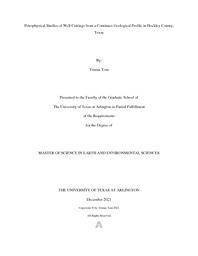
ATTENTION: The works hosted here are being migrated to a new repository that will consolidate resources, improve discoverability, and better show UTA's research impact on the global community. We will update authors as the migration progresses. Please see MavMatrix for more information.
Show simple item record
| dc.contributor.advisor | Hu, Qinghong | |
| dc.creator | Tom, Tristan N | |
| dc.date.accessioned | 2022-01-25T18:21:57Z | |
| dc.date.available | 2022-01-25T18:21:57Z | |
| dc.date.created | 2021-12 | |
| dc.date.issued | 2021-12-09 | |
| dc.date.submitted | December 2021 | |
| dc.identifier.uri | http://hdl.handle.net/10106/30204 | |
| dc.description.abstract | The Permian Basin currently leads the oil production in the United States; however, with increasing concerns for the global climate, it is crucial for oil and gas companies to operate as economically and efficiently as possible. This is where the use of well cuttings comes in, as they allow for more geological formations in the subsurface to be analyzed in depth and are cheaper to achieve than core samples. Well cuttings can be obtained from most drilling operations, and they can save on analysis time and even be analyzed on site. Before using well cuttings, it is important to ensure that the well cuttings give a good data and are a viable substitution and supplementation for core samples. This study investigated the viability of well cuttings using various tests of helium pycnometry, enveloping density, X-ray diffraction (XRD), pyrolysis, total organic carbon (TOC), and gas diffusion tests. These integrated tests produced data for petrophysical properties such as particle density, bulk density, porosity, mineralogical content, TOC content, thermal maturity, and gas diffusion coefficient. Well cutting samples were obtained from one well, Spade K in Hockley County, Texas. A total of 12 sample intervals from this well covered a 3340-foot depth range to include five different geologic formations. The testing results of these well cutting samples suggest that particle density, bulk density, thermal maturity, and pyrolysis data can all be obtained from well cutting samples, replacing core samples with current laboratory practices. For X-ray diffraction, more information on drilling fluid is needed, and sample preparation will need to be adjusted but the experimental procedures are adequate. Gas diffusion testing in this study were inconclusive. | |
| dc.format.mimetype | application/pdf | |
| dc.language.iso | en_US | |
| dc.subject | Well cuttings | |
| dc.subject | Wolfcamp | |
| dc.subject | Clearfork | |
| dc.subject | Dean | |
| dc.subject | Cisco | |
| dc.subject | Petrophysical | |
| dc.title | Petrophysical Studies of Well Cuttings from a Continues Geological Profile in Hockley County, Texas | |
| dc.type | Thesis | |
| dc.degree.department | Earth and Environmental Sciences | |
| dc.degree.name | Master of Science in Earth and Environmental Science | |
| dc.date.updated | 2022-01-25T18:21:57Z | |
| thesis.degree.department | Earth and Environmental Sciences | |
| thesis.degree.grantor | The University of Texas at Arlington | |
| thesis.degree.level | Masters | |
| thesis.degree.name | Master of Science in Earth and Environmental Science | |
| dc.type.material | text | |
| dc.creator.orcid | 0000-0002-0840-5016 | |
Files in this item
- Name:
- TOM-THESIS-2021.pdf
- Size:
- 2.130Mb
- Format:
- PDF
This item appears in the following Collection(s)
Show simple item record


